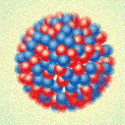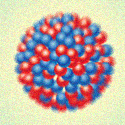Weighty matters
Atomic nuclei are held together by the attractive strong force between protons and neutrons. However, protons have positive electrical charge and therefore repel each other. In the heaviest nuclei this repulsion is so strong that the nuclei would instantly fly apart were it not for quantum mechanics: the outermost nucleons occupy specific quantum orbits—analogous to electron orbits in an atom—whose energies give extra binding.
This mechanism has been understood for some time, but it came as a huge surprise when scientists discovered they could produce heavy nuclei with an atomic mass 250, even when the outermost nucleons formed states with angular momentum values as high as 20 ℏ. Just as the ball swung by a shot putter is thrown outward by the centrifugal force, it was expected that, combined with the Coulomb repulsion, nuclei in such states would instantly shatter.
Instead, it is the field of heavy nuclei that has exploded. In a Rapid Communication appearing in Physical Review C, Paul Greenlees at the University of Jyväskylä in Finland and colleagues are able to detect the gamma-ray decay from a long-lived (half-life 2 s) excited state in . This allows the group to identify specific, high angular momentum nucleon configurations involved in the transition, which suggests a shell structure that modern nuclear theory cannot explain.
The study is a superb example of the experimental challenges involved in the measurement of nuclei with large atomic mass and is an essential step towards understanding the potential stability of super-heavy nuclei, whose existence is being so actively sought. –- Rick Casten





